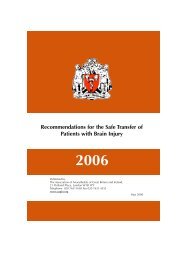TheatrePracticeStandardsGeneric1
Create successful ePaper yourself
Turn your PDF publications into a flip-book with our unique Google optimized e-Paper software.
• The active electrode must always be stored securely in a non-conductive container<br />
when not in use.<br />
• The active electrode must only be activated by the person holding the device.<br />
• Active electrodes must not be used in the presence of flammable substances, including<br />
anti-microbial skin preparations, and tinctures.<br />
• The active electrode should not be used in the presence of intestinal gases, as these<br />
contain hydrogen and methane, which are highly flammable.<br />
• Head and Neck (H&N) Procedures<br />
• During H&N procedures a careful risk assessment must be performed to assess the<br />
proximity of the surgical field and combustible airway devices/anaesthetic gases.<br />
Where a risk is identified, measures must be taken to reduce this risk.<br />
• In order to avoid any risk of ignition by skin prep, only aqueous antiseptic skin prep<br />
solution may be used.<br />
• Careful consideration must be given to the potential accumulation of anaesthetic gases<br />
and in particular oxygen under drapes e.g. patients undergoing procedures under local<br />
with oxygen supplementation. Particular attention must be given to prepping, draping<br />
and positioning the patient to reduce this risk.<br />
• Where there is a potential risk of airway fires, the use of N²0 is not recommended as<br />
this gas supports combustion.<br />
• Where possible, in situations where an airway fire is a risk, closed/semi closed<br />
anaesthetic breathing systems and cuffed endo-tracheal tubes should be used. The<br />
Mistral jet ventilation system can be useful as it can provide variable FIO2 from 21-<br />
100%. However, it must not be used by anyone untrained in it's use and if required,<br />
attempts should be made to find a clinician able to use it safely.<br />
• If the risk assessment determines the anaesthetic/surgical procedure: a potentially high<br />
risk for igniting, then high oxygen concentrations must be avoided.<br />
• The use of diathermy is contraindicated whilst the patient is receiving 100% oxygen.<br />
• Draping and positioning the patient should be performed in a manner that does not<br />
allow pooling of oxygen under the drapes.<br />
• If facial hair is exposed, coat the hair with a water-soluble surgical lubricating jelly to<br />
make it non-flammable.<br />
• Additionally, moisten sponges, gauze and pledgets (and their strings) to render them<br />
ignition resistant.<br />
• Theatre staff should be made aware that an airway fire may occur during<br />
tracheostomy. It is recommended that a bowl of saline is available on the surgical<br />
instrument trolley at all times.<br />
• Laser safety<br />
• There is no UK legislation specific to non-ionising radiation protection. Therefore, the<br />
following legislation is most relevant: the Health and Safety at Work etc Act 1974; the<br />
Management of Health and Safety at Work Regulations 1999 and the Health and<br />
Safety (Safety Signs and Signals) Regulations 1996.<br />
• In the United Kingdom, the Radiation Protection Division of the Health Protection<br />
Agency (HPARPD) (formerly the National Radiological Protection Board) advises the<br />
government providing guidance and recommendations on protection from both ionising<br />
and non-ionising radiation.<br />
58





